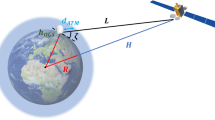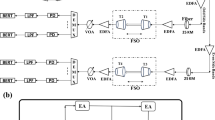Abstract
In recent years, free space optical communication (FSO) has gained amorous importance and become an interesting alternative to radio frequency communication because of its numerous benefits over radio frequency communication. It is efficient, low power, high data rate, unlicensed spectrum, and large bandwidth wireless technology. Despite, these advantages FSO is prone to the atmospheric attenuation, but in order to compensate this problem the MIMO FSO system is considered to be a good solution. This paper analyzes the performance of 4*4 MIMO FSO system using different modulation schemes, NRZ, RZ, and CSRZ. The impact of varying, Link range, attenuation factor and transmits power on the performance of 4*4 MIMO FSO has been observed in terms of Quality factor and eye diagram while keeping the other parameters constant. The results show that the RZ modulation scheme using 4*4 MIMO FSO technique show better performance as compare to NRZ and CSRZ. For low attenuation and small link, RZ is superior to NRZ and CSRZ while for higher attenuation and larger link the performance of RZ and NRZ is equivalent. Overall RZ performs better than NRZ and CSRZ. It is also evident from the results that as the number of transmitter and receiver are increased, the efficiency of the system increases. With MIMO technology the performance of FSO system improves to a larger extent.
















Similar content being viewed by others
References
Talib, M., Rahman, A., Anuar, M., Rashidi, C., Aljunid, S., & Ibrahim, Z. (2017). The performance of varies data rate in free space optical communication system using dual diffuser modulation. International Journal of Applied Engineering Research, 12(7), 1401–1405.
Soni, G., & Banga, V. K. (2014). Performance analysis of free space optics link at different data rates. In Contemporary computing and informatics (IC3I), 2014 international conference on (pp. 1251–1255). IEEE.
Ghassemlooy, Z., Popoola, W., & Rajbhandari, S. (2012). Optical wireless communications: System and channel modelling with Matlab®. CRC Press.
Peppas, K., Nistazakis, H. E., Assimakopoulos, V. D., & Tombras, G. S. (2012). Performance analysis of siso and mimo fso communication systems over turbulent channels. In Optical communication. InTech.
Ali, M. A. A. (2014). Comparison of nrz, rz-ook modulation formats for fso communications under fog weather condition. International Journal of Computer Applications, 108(2).
Singh, H., & Singh, G. (2017). Performance analysis of mimo fso link employing different modulation techniques.
Israr, A., Rauf, Z., Muhammad, J., & Khan, F. (2017). Performance analysis of downlink linear precoding in massive mimo systems under imperfect csi. Wireless Personal Communications, 96(2), 2603–2619.
Henniger, H., & Wilfert, O. (2010). An introduction to free-space optical communications. Radioengineering, 19(2).
Majumdar, A. K., & Ricklin, J. C. (Eds.) (2010). Free-space laser communications: Principles and advances (Vol. 2). Springer.
David, F. (2004). Scintillation loss in free-space optic im/dd systems. In Free-space laser communication technologies XVI (Vol. 5338, pp. 65–76). International Society for Optics and Photonics.
Singh, M. (2016). Simulative analysis of 10 gbps high speed free space optical communication link. International Journal of Future Generation Communication and Networking, 9(3), 139–144.
Kaur, G., Singh, H., & Sappal, A. S. (2017). Free space optical using different modulation techniques—a review. International Journal of Engineering Trends and Technology (IJETT), 43(2).
Kaushal, H., & Kaddoum, G. Optical communication in space: Challenges and mitigation techniques. IEEE Communications Surveys & Tutorials, 19(1).
Talib, M., Rahman, A., Anuar, M., Rashidi, C., & Aljunid, S. (2016). Enhancement of free space optical communication system modulation using ddm technique. In Electronic design (ICED), 2016 3rd international conference on (pp. 62–65). IEEE.
Israr, A., Junaid, M., & Israr, A. (2015). Performance analysis of advance optical modulation formats for gpon system. In Frontiers of information technology (FIT), 2015 13th international conference on (pp. 77–80). IEEE.
Israr, A., & Junaid, M. (2016). Carrier suppressed return-to-zero (csrz) and modified duobinary return-to-zero (mdrz) advance optical modulation formats analysis for long haul rural coverage. Journal of Applied and Emerging Sciences, 6(2), 61–65.
Majumdar, A. K. (2014). Advanced free space optics (FSO): A systems approach (Vol. 186). Springer.
Ali, M. A. A. Comparison of nrz, rz-ook modulation formats for fso communications under fog weather condition.
Ijaz, M., Ghassemlooy, Z., Ansari, S., Adebanjo, O., Le Minh, H., Rajbhandari, S., & Gholami, A. (2010). Experimental investigation of the performance of different modulation techniques under controlled fso turbulence channel. In 2010 5th International symposium on telecommunications (pp. 59–64). IEEE.
Sharma, K. T. A., & Thakur, K. (2017). Comparison of mdrz, csrz and drz schemes using different communiation channels. International Journal Of Computer Applications.
Mazin, A. A. A. (2016). Performance analysis of wdm-fso link under turbulence channel. World Scientific News, 50, 160–173.
Kashani, M. A., Uysal, M., & Kavehrad, M. (2015). On the performance of mimo fso communications over double generalized gamma fading channels. In Communications (ICC), 2015 IEEE international conference on (pp. 5144–5149). IEEE.
Mahdavi, F. A., & Samimi, H. (2016). Performance analysis of mimo-fso communication systems in gamma–gamma turbulence channels with pointing errors. In Electrical engineering (ICEE), 2016 24th Iranian conference on (pp. 822–827). IEEE.
Nadeem, L., Qazi, M. S., & Hassam, A. (2018). Performance of fso links using csrz, rz, and nrz and effects of atmospheric turbulence. Journal of Optical Communications, 39(2), 191–197.
Author information
Authors and Affiliations
Corresponding author
Additional information
Publisher's Note
Springer Nature remains neutral with regard to jurisdictional claims in published maps and institutional affiliations.
Rights and permissions
About this article
Cite this article
Israr, A., Israr, A., Khan, F. et al. Optimal Modulation Technique for MIMO FSO Link. Wireless Pers Commun 109, 695–714 (2019). https://doi.org/10.1007/s11277-019-06586-6
Published:
Issue Date:
DOI: https://doi.org/10.1007/s11277-019-06586-6




